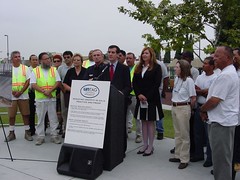I had been inspired by the example of Ron Gonzales, the mayor of San Jose, CA, who had remarkable successes lowering graffiti in San Jose. However, when my staff spent a day driving CD13 block by block to count tags, we found densities of up to ten times the graffiti found in San Jose. Still, we had our base number (20,763 tags in the 13.13 square miles of CD13) and we knew what we had to do to bring that number down.
The key to our success was our recruitment of block captains. Starting with the thirty or so people who signed up at our kickoff, we reached 100 block captains, people who took responsibility for reporting any instances of graffiti to our paint-out crews, either by calling our office directly or by using 3-1-1. We also won funding for security cameras (PDF) to be placed in parks such as Lake Street Park, whose brand new skate park, recreation center and playground had all been marred by acts of vandalism in the first months of its young existence. A year after our initial benchmark count—a year in which constant, block-captain-driven graffiti reporting had substantially increased the workload for our paint-out crews, Central City Action Coalition and Hollywood Beautification Team—my staff and I drove the district once again, counting tags with the same methodology we had used a year before. The results were astonishing. The entire day turned up only 7,970 tags: a 62% reduction in only one year.
Jocelyn Geaga-Rosenthal, a block captain from Historic Filipinotown, captured it best at the press conference announcing the results when she said, "Fighting graffiti is like brushing your teeth. You have to do it every day to see results." She added: "But now my neighborhood has a great big smile." UNTAG did the job with neighbors' engagement, smart police work, and real care. Let's keep up the momentum of reducing graffiti. Won't you become a block captain (PDF) today?

